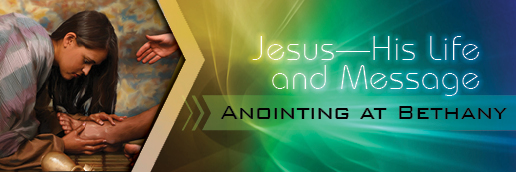
イエス、その生涯とメッセージ: ベタニヤで香油を塗られる
12月 15, 2020
著者:ピーター・アムステルダム

イエス、その生涯とメッセージ: ベタニヤで香油を塗られる
[Jesus—His Life and Message: Anointing at Bethany]
December 15, 2020
ヨハネ11章には、イエスがラザロを生き返らされたことが書かれています。[1] この奇跡の結果、祭司長たちやパリサイ(ファリサイ)人たちは、イエスは殺されなければいけないということで意見が一致したので、イエスを逮捕するため、居所を知っている者は届け出なければいけないという命令を出しました。そのため、「イエスは、もはや公然とユダヤ人の間を歩かないで、そこを出て、荒野に近い地方のエフライムという町に行かれ、そこに弟子たちと一緒に滞在しておられた。」 [2] イエスがどのくらいそこに滞在されたかは書かれていませんが、しばらく経つと、ふたたび移動されました。
過越の祭の六日まえに、イエスはベタニヤに行かれた。そこは、イエスが死人の中からよみがえらせたラザロのいた所である。イエスのためにそこで夕食の用意がされ、マルタは給仕をしていた。イエスと一緒に食卓についていた者のうちに、ラザロも加わっていた。[3]
ベタニヤは、エルサレムから3キロほど離れた所にありました。[4] イエスが到着すると、もてなしの食事会が開かれ、福音書の別の箇所にもあるように、マルタが給仕をしました。[5] その兄弟であり、イエスによって生き返らされていたラザロは、食卓についています。
マルタとラザロの妹マリヤもそこにいました。
その時、マリヤは高価で純粋なナルドの香油一斤を持ってきて、イエスの足にぬり、自分の髪の毛でそれをふいた。すると、香油のかおりが家にいっぱいになった。[6]
マリヤがイエスの足に塗った香油は高価なものでした。スパイクナード(甘松香)とも呼ばれるこの香油は、現在のネパール、中国、インドにあたるヒマラヤの一帯に自生する植物から取られたもので、イスラエルではそれを輸入しなければいけなかったからです。マリヤが使った香油を換算すれば、327グラムほどなので、かなりお金のかかることをしています。
このような香油は通常、頭に塗られるものであり、マリヤがそれをイエスの足に塗ったのは、謙虚な行為と見ることができます。一般的に、他人の足のケアをしていたのは最下級の奴隷や僕だったので、彼女は自分を最も低い立場に置いたことになるのです。さらに、自分の髪の毛でイエスの足から余分の油を拭き取ることにより、マリヤはイエスへの愛と忠誠を表明したのでした。ユダヤ人女性が公の場で髪の毛をあらわにすることは、決してありませんでした。なぜなら、それはふしだらな女のしるしと考えられていたからです。ある人は、このように説明しています。「マリヤは、手を止めて周りの反応を計算することはしませんでした。彼女は主の心情を思い、この美しく心に触れる行動によって、自分の気持を表現したのです。」 [7]
弟子のひとりで、イエスを裏切ろうとしていたイスカリオテのユダが言った、「なぜこの香油を三百デナリに売って、貧しい人たちに、施さなかったのか。」 [8]
ユダはもっともな質問をしました。1デナリは1日分の賃金にあたったので、この香油には、1年分の賃金に近い価値があります。それだけのお金があれば、かなりの数の貧しい人たちを助けられたことでしょう。しかし、マリヤの行動は、自分の兄弟ラザロがイエスによって生き返らされたことや、イエスからのそのかけがえのない贈り物を彼女がどれほど感謝していたか、という観点から見なければいけません。[9]
お金の使い方についてユダが質問をした動機は、次の節で明らかにされます。
彼がこう言ったのは、貧しい人たちに対する思いやりがあったからではなく、自分が盗人であり、財布を預かっていて、その中身をごまかしていたからであった。[10]
ユダは盗人でした。イエスと弟子たちが共有するお金の管理を任されていたのですが、信頼を裏切ってお金を盗み、自分のために使っていました。高価な香油をイエスの足に塗ることに反対した真の動機は、利己的なものです。香油が売られたとしたら、ユダはそのお金に手を付け、一部をくすねることができました。ユダがイエスを裏切る前に、品格の悪さを示している箇所は、福音書でここだけです。
イエスは言われた、「この女のするままにさせておきなさい。わたしの葬りの日のために、それをとっておいたのだから。貧しい人たちはいつもあなたがたと共にいるが、わたしはいつも共にいるわけではない。」 [11]
イエスはすぐにマリヤを擁護されました。マルコ書では、イエスは次のようにマリヤをほめておられます。
[マリヤは]わたしによい事をしてくれたのだ。…わたしのからだに油を注いで、あらかじめ葬りの用意をしてくれたのである。[12]
イエスが指摘されたのは、貧しい人たちはこれからも常にいるけれど、イエスはそうでないので、マリヤがこの機を捉えてイエスへの愛と忠誠を行動で示したのは正しかったということです。
大ぜいのユダヤ人たちが、そこにイエスのおられるのを知って、押しよせてきた。それはイエスに会うためだけではなく、イエスが死人のなかから、よみがえらせたラザロを見るためでもあった。[13]
ベタニヤはエルサレムからわずか3キロほどの所にあったので、ラザロを生き返らせたイエスがベタニヤにいることがエルサレムまで伝わった時、好奇心の強い大勢の人たちが、奇跡を行ったイエスやラザロに会えるかもしれないと、やってきたのです。
イエスとラザロを見ようと群衆が来たことに注目した人たちがいます。この福音書の少し前に、「祭司長たちとパリサイ人たちとは、イエスを捕えようとして、そのいどころを知っている者があれば申し出よ、という指令を出していた」とあります。 [14] 彼らの目的はイエスを殺すことであり、それは、指令を出す前に大祭司カヤパ(カイアファ)がこう言っていたとおりです。「ひとりの人が人民に代って死んで、全国民が滅びないようになるのがわたしたちにとって得だ。」 [15] そして今、祭司長たちが「死ぬべきだ」と考える人のリストにラザロも付け加えられたのです。
そこで祭司長たちは、ラザロも殺そうと相談した。それは、ラザロのことで、多くのユダヤ人が彼らを離れ去って、イエスを信じるに至ったからである。[16]
イエスと同様、ラザロにも危険が迫っていました。
宗教界の最高権威者たちがラザロを始末したかったのは、彼が生き返らされたという証が、イエスとそのメッセージを裏付ける強力な証拠となったからです。この箇所には書かれていませんが、イエスがラザロを生き返らせたことは、宗教指導者たち、特にサドカイ人たちに恥をかかせることであったと考えられます。彼らは死者の復活はないと主張していたのに、墓の中に4日もいた人がこうして生き返ったのですから。
マリヤ、マルタ、ラザロと夕食を共にされたことで、イエスが彼らの家にいるという話が広まり、大勢の人たち(恐らくはエルサレムの住人)がイエスとラザロを見ようとベタニヤにやってきました。その結果、「多くのユダヤ人が彼らを離れ去って、イエスを信じるに至った」 [17] のです。
この時点から、福音書は、イエスがエルサレムで行われた最後の宣教に焦点を当てていき、その後に逮捕と裁判と十字架刑が続きます。
注:
聖書の言葉は、特に明記されていない場合、日本聖書協会の口語訳聖書から引用されています。
参考文献
Bailey, Kenneth E. Jesus Through Middle Eastern Eyes. Downers Grove: InterVarsity Press, 2008.
Biven, David. New Light on the Difficult Words of Jesus. Holland: En-Gedi Resource Center, 2007.
Bock, Darrell L. Jesus According to Scripture. Grand Rapids: Baker Academic, 2002.
Bock, Darrell L. Luke Volume 1: 1:1–9:50. Grand Rapids: Baker Academic, 1994.
Bock, Darrell L. Luke Volume 2: 9:51–24:53. Grand Rapids: Baker Academic, 1996.
Brown, Raymond E. The Birth of the Messiah. New York: Doubleday, 1993.
Brown, Raymond E. The Death of the Messiah. 2 vols. New York: Doubleday, 1994.
Carson, D. A. Jesus’ Sermon on the Mount and His Confrontation with the World. Grand Rapids: Baker Books, 1987.
Charlesworth, James H., ed. Jesus’ Jewishness, Exploring the Place of Jesus Within Early Judaism. New York: The Crossroad Publishing Company, 1997.
Chilton, Bruce, and Craig A. Evans, eds. Authenticating the Activities of Jesus. Boston: Koninklijke Brill, 1999.
Edersheim, Alfred. The Life and Times of Jesus the Messiah. Updated Edition. Hendrickson Publishers, 1993.
Elwell, Walter A., ed. Baker Encyclopedia of the Bible. Grand Rapids: Baker Book House, 1988.
Elwell, Walter A., and Robert W. Yarbrough. Encountering the New Testament. Grand Rapids: Baker Academic, 2005.
Evans, Craig A. World Biblical Commentary: Mark 8:27–16:20. Nashville: Thomas Nelson, 2000.
Evans, Craig A., and N. T. Wright. Jesus, the Final Days: What Really Happened. Louisville: Westminster John Knox Press, 2009.
Flusser, David. Jesus. Jerusalem: The Magnes Press, 1998.
Flusser, David, and R. Steven Notely. The Sage from Galilee: Rediscovering Jesus’ Genius. Grand Rapids: William B. Eerdmans Publishing Company, 2007.
France, R. T. The Gospel of Matthew. Grand Rapids: William B. Eerdmans Publishing Company, 2007.
Gnilka, Joachim. Jesus of Nazareth: Message and History. Peabody: Hendrickson Publishers, 1997.
Green, Joel B. The Gospel of Luke. Grand Rapids: William B. Eerdmans Publishing Company, 1997.
Green, Joel B., and Scot McKnight, eds. Dictionary of Jesus and the Gospels. Downers Grove: InterVarsity Press, 1992.
Grudem, Wayne. Systematic Theology, An Introduction to Biblical Doctrine. Grand Rapids: InterVarsity Press, 2000.
Guelich, Robert A. World Biblical Commentary: Mark 1–8:26. Nashville: Thomas Nelson, 1989.
Jeremias, Joachim. The Eucharistic Words of Jesus. Philadelphia: Trinity Press International, 1990.
Jeremias, Joachim. Jerusalem in the Time of Jesus. Philadelphia: Fortress Press, 1996.
Jeremias, Joachim. Jesus and the Message of the New Testament. Minneapolis: Fortress Press, 2002.
Jeremias, Joachim. New Testament Theology. New York: Charles Scribner’s Sons, 1971.
Jeremias, Joachim. The Prayers of Jesus. Norwich: SCM Press, 1977.
Keener, Craig S. The Gospel of John: A Commentary, Volume 1. Grand Rapids: Baker Academic, 2003.
Keener, Craig S. The Gospel of John: A Commentary, Volume 2. Grand Rapids: Baker Academic, 2003.
Keener, Craig S. The Gospel of Matthew: A Socio-Rhetorical Commentary. Grand Rapids: William B. Eerdmans Publishing Company, 2009.
Lewis, Gordon R., and Bruce A. Demarest. Integrative Theology. Grand Rapids: Zondervan, 1996.
Lloyd-Jones, D. Martyn. Studies in the Sermon on the Mount. Grand Rapids: William B. Eerdmans Publishing Company, 1976.
Manson, T. W. The Sayings of Jesus. Grand Rapids: William B. Eerdmans Publishing Company, 1957.
Manson, T. W. The Teaching of Jesus. Cambridge: University Press, 1967.
McKnight, Scot. Sermon on the Mount. Grand Rapids: Zondervan, 2013.
Michaels, J. Ramsey. The Gospel of John. Grand Rapids: William B. Eerdmans Publishing Company, 2010.
Milne, Bruce. The Message of John. Downers Grove: InterVarsity Press, 1993.
Morris, Leon. The Gospel According to John. Grand Rapids: William B. Eerdmans Publishing Company, 1995.
Morris, Leon. The Gospel According to Matthew. Grand Rapids: William B. Eerdmans Publishing Company, 1992.
Morris, Leon. Luke. Downers Grove: InterVarsity Press, 1988.
Ott, Ludwig. Fundamentals of Catholic Dogma. Rockford: Tan Books and Publishers, Inc., 1960.
Pentecost, J. Dwight. The Words & Works of Jesus Christ. Grand Rapids: Zondervan, 1981.
Sanders, E. P. Jesus and Judaism. Philadelphia: Fortress Press, 1985.
Sheen, Fulton J. Life of Christ. New York: Doubleday, 1958.
Spangler, Ann, and Lois Tverberg. Sitting at the Feet of Rabbi Jesus. Grand Rapids: Zondervan, 2009.
Stassen, Glen H., and David P. Gushee. Kingdom Ethics: Following Jesus in Contemporary Context. Downers Grove: IVP Academic, 2003.
Stein, Robert H. Jesus the Messiah. Downers Grove: InterVarsity Press, 1996.
Stein, Robert H. Mark. Grand Rapids: Baker Academic, 2008.
Stein, Robert H. The Method and Message of Jesus’ Teachings. Louisville: Westminster John Knox Press, 1994.
Stein, Robert H. The New American Commentary: Luke. Nashville: B&H Publishing Group, 1992.
Stott, John R. W. The Message of the Sermon on the Mount. Downers Grove: InterVarsity Press, 1978.
Talbert, Charles H. Reading the Sermon on the Mount. Grand Rapids: Baker Academic, 2004.
Williams, J. Rodman. Renewal Theology: Systematic Theology from a Charismatic Perspective. Grand Rapids: Zondervan, 1996.
Witherington, Ben, III. The Christology of Jesus. Minneapolis: Fortress Press, 1990.
Witherington, Ben, III. The Gospel of Mark: A Socio-Rhetorical Commentary. Grand Rapids: William B. Eerdmans Publishing Company, 2001.
Wood, D. R. W., I. H. Marshall, A. R. Millard, J. I. Packer, and D. J. Wiseman, eds. New Bible Dictionary. Downers Grove: InterVarsity Press, 1996.
Wright, N. T. After You Believe. New York: Harper Collins Publishers, 2010.
Wright, N. T. Jesus and the Victory of God. Minneapolis: Fortress Press, 1996.
Wright, N. T. Matthew for Everyone, Part 1. Louisville: Westminster John Knox Press, 2004.
Wright, N. T. The Resurrection of the Son of God. Minneapolis: Fortress Press, 2003.
Yancey, Philip. The Jesus I Never Knew. Grand Rapids: Zondervan, 1995.
Young, Brad H. Jesus the Jewish Theologian. Grand Rapids: Baker Academic, 1995.
